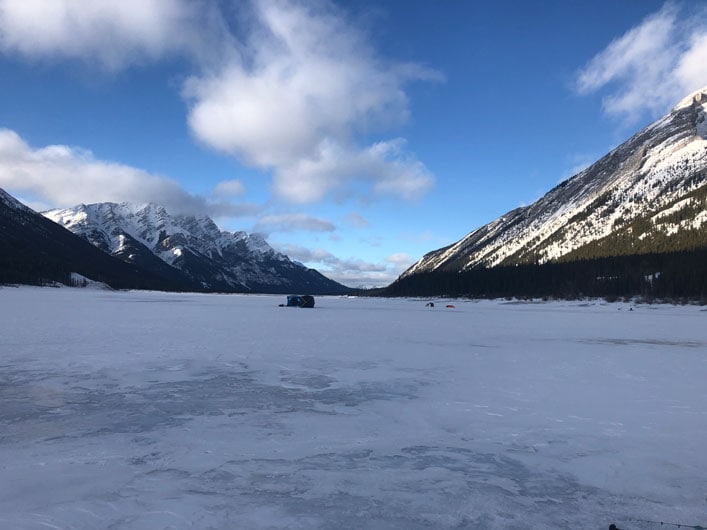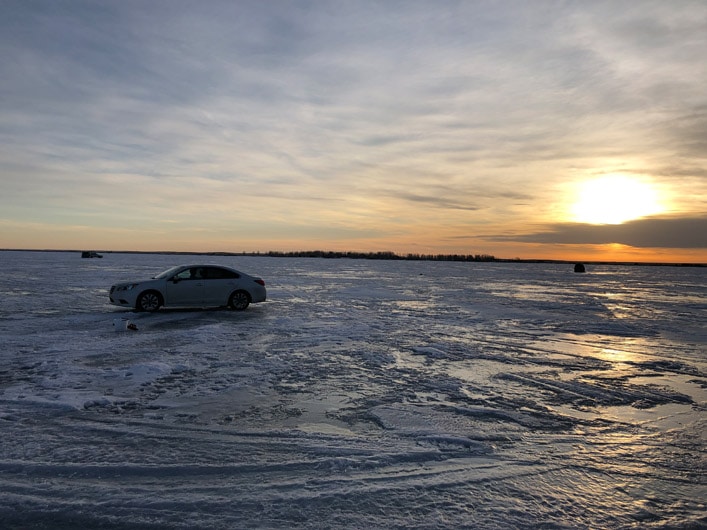For many fishermen in Alberta, ice fishing is the best type of fishing.
Open-water fishing can be fun as well, but there is something special about being out on the ice in the middle of the lake surrounded by snowy trees and mountains.
If you never ice fished before and want to give it a try, or you are just looking for a new winter hobby, in this article, you will find everything you need to get started.
Some people think that ice fishing is expensive. However, it is not true, and you can easily get everything you need to start ice fishing for less than a couple of hundred bucks.
Others are scared of cold weather and think that ice fishing is a miserable experience, and it can be if you are not properly prepared.
That’s why we created this ice fishing guide to get you started so that you can have all the fun while avoiding common mistakes that beginners make when ice fishing for the first time.
How Long is Ice Fishing Season in Alberta?

The ice fishing season in Alberta usually starts at the beginning of December and can run to the end of April, depending on the weather.
Different lakes in Alberta have different regulations when it comes to fishing season, bait you can use, and how much fish you can keep.
It is always a good idea to check the rules before planning your trip.
You can find the latest Alberta fishing regulations here.
Basic Alberta Fishing Regulations
To fish anywhere in Alberta, you will need to get a fishing license that costs around $28 and can be purchased at Canadian Tire, some fishing shops, and online at AlbertaRELM.
The license costs a little more if you are visiting Alberta from other provinces or don’t live in Canada.
You will need to carry your fishing license whenever fishing in Alberta.
You don’t need a fishing license if you are under 16 or over 65 years of age. However, you still have to follow all the fishing rules.
If you never bought a fishing license before, you will also need to get Alberta WIN (Wildlife Identification Number) card that costs around $8.
The fishing license lasts for a year and expires at the end of March.
The main difference when it comes to regulations for open water fishing and ice fishing is that you can ice fish with two rods in the winter while only one rod can be used in the summer.
However, you are not allowed to fish through the ice in the moving water (rivers and streams).
Now that you know the basic rules, let’s take a look at the gear that you will need to start ice fishing.
We will separate all the gear into two categories: things that you need to start ice fishing and things that are nice to have.
Need to Have Ice Fishing Gear
1. Ice Fishing Rod or Tip-Up
Spinning Ice Fishing Combos | Tip-Up
Most people have separate fishing rods for open water and ice fishing. Ice fishing rods are shorter and usually more flexible than longer rods used for open-water fishing.
Theoretically, you can use your longer summer rod for ice fishing, but it will be harder to position it as well as to notice bites.
If you are tight on budget, you can try modifying your summer rod for winter fishing by removing the reel and attaching it to the top section of your summer rod with tape or rope.
Tip-up is a device that has a reel and a line with bait.
When the fish bites, the reel starts to spin and activates an indicator (usually a flag) that tells the fisherman that the fish is biting.
Tip-ups work great for pike, burbot, and walleye when using minnows or smelts as bait.
2. Ice Fishing Line, Hooks, and Leader

Most fishermen prefer to use a winter fishing line that doesn’t freeze and breaks as easily as the regular line you would use for summer fishing, but it is not a requirement.
The size of the line you will use will depend on the fish species you are targeting.
If you are fishing in the lakes stocked with trout, a 6-8 pound line should be enough.
For predators like pike, burbot, and walleye, you will want to have at least a 12-pound line.
You will also need a steel leader because fish like pike can easily bite through your line.

3. Ice Fishing Auger
You will need to have an ice fishing auger to make the holes in the ice.
Ice augers come in different sizes and configurations depending on where you are going to fish and how much money you are willing to spend.
Ice augers can be manual, gas-powered, or electrical.
Manual ice augers are the cheapest, the lightest, and work well when the blades are sharp, and the ice is not too thick.

Some people modify manual augers by connecting an electric drill to them to make it easier to drill the hole.
Gas-powered ice augers are more expensive and heavier but make it much easier to drill the holes, especially when ice fishing in the early spring when the ice is the thickest.

Electrical ice augers are lighter than gas-powered ones and much quieter but usually more expensive.

Ice augers also come in different sizes. The most common sizes are 6”,8”,10”.
6” auger will be enough for most lakes unless you are pulling absolute monsters and that’s when you will need something bigger.
One thing to keep in mind is that if you have a manual ice auger drilling the hole in the ice with a 6” auger will be much easier than doing it with an 8” or 10” one.
Another thing to consider is that it is much easier to lose a fishing rod or drop stuff in the hole when using larger-diameter augers. This is especially important when fishing with younger kids.
Losing rods in the hole is not as uncommon as you may think, and it happens to the best of us when not paying attention (this unfortunately is coming from my personal experience).
4. Bait and Lures
The most common bait for ice fishing is nightcrawlers and jigs tipped with minnows.
However, the type of bait you will use will depend on what type of fish you are targeting.
- Rainbow trout: Nightcrawlers, PowerBait, Velveeta cheese, shrimp, maggots, and corn
- Lake trout: Minnows, smelts, or nightcrawlers
- Perch: Small jigs with minnows, maggots, or nightcrawlers
- Pike, Walleye, and Burbot: Minnows or smelts depending on regulations
- Whitefish: Wireworms
If you fish at night, glow-in-the-dark jigs can sometimes get you more action.

In general, when ice fishing, smelly bait will work better than metal lures because the water is not as clear as in summer, and the fish has to rely on smell.
5. Ice Skimmer (Scoop)

Having some type of scoop will make it much easier to remove the ice from the hole while you fish. This is a simple and cheap tool that can make your life much easier.
6. Ice Rod Holder
When ice fishing, you will need to secure your rod, especially when fishing for larger size fish to prevent it from pulling your rod into the water.
Many beginners just use snow to secure their rod, but it only works for smaller size fish.
Ice holders come in all types of sizes and configurations.
Cheaper ones are usually just made of spiraled metal wire, while more advanced ones have an automatic jigging mechanism.

7. Proper Ice Fishing Clothing
Being well-dressed can make your fishing trip much more fun. The last thing you want is to get frostbite when ice fishing.
Here are some pieces of clothing that might be useful when ice fishing.
- Jacket
- Pants
- Gloves
- Rubber boots
- Ice cleats
Lastly, if you don’t want to stand the entire day, it is a good idea to bring a chair.
Even if you are not planning to sit most of the day, I find it useful to put all my stuff on a chair so that it doesn’t get wet, especially when fishing without a sled or ice fishing tent.
Alternatively, you can bring a bucket that you can use as a chair.
Nice to Have Ice Fishing Gear
1. Ice Fishing Sled

If you are not able to drive directly to the spot where you will be fishing either because the ice is thin or there is no easy access, you will have to carry all your fishing gear, and that’s where the sled might be very handy.
2. Ice Fishing Hut or Tent

When fishing in very cold, windy weather, having a shelter can make your ice fishing experience much more enjoyable.
Ice fishing tents come in different shapes and sizes depending on your budget and needs.
It also might be a good idea to get a heater to keep the tent warm.
3. Ice Fishing Sonar (Flasher)

When you are fishing through the ice, you usually have no idea what is happening underwater, and that is when flasher can be very useful, especially if you are fishing for the first time on the new lake.
It can also help you to hook the fish because you will be able to see when it gets closer to your bait.
Best Spots to Ice Fish in Southern Alberta

Here are some great spots if you live in Calgary, Red Deer, and Lethbridge area:
- Chain Lakes Reservoir – rainbow trout and suckers
- Spray Lakes Reservoir – lake trout and whitefish
- Eagle Lake – pike and walleye
- Crawling Valley Reservoir – pike, burbot, walleye, and perch
- Dalemead Lake – pike
- Pine Coulee Reservoir – pike, walleye and rainbow trout
- Upper and Lower Kananaskis Lakes – rainbow, bull and cutthroat trout
- McGregor Reservoir – pike, walleye, burbot and whitefish
- Travers Reservoir – pike, walleye, burbot and whitefish
- Sylvan Lake – burbot, walleye, pike and whitefish
- Lake Newell – walleye, pike, whitefish and burbot
- Twin Valley Reservoir – pike
- Clear Lake – pike
Safety Tips For Ice Fishing

Before you start walking or driving on a frozen lake it is important to make sure that the ice is safe.
- less than 4″ – Ice is unsafe
- 4″ – Ice is safe for walking
- 12″ – Ice is safe for driving with a small car
- 15″ – Ice is safe for driving with a big car or pickup
It is always a good idea to pay attention to what other fishermen are doing if you are not familiar with a lake.
Some lakes might have underwater currents that can decrease the ice thickness in some spots. Be especially careful near inlets.
When driving on the ice don’t speed, keep your belt off and window slightly open so that you can escape if the car breaks through the ice.
Driving too fast on the ice can create waves that can damage the ice.
Refer to the ice safety sheet from the Government of Alberta below:



Latest Fishing Reports